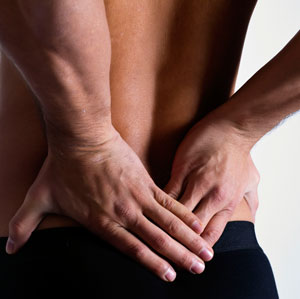
The tailbone is an interesting part of our bodies, and many have argued that this vestigial series of bones are actually structures from a time when our species had tails. The truth about humans having tails at one point in evolution is unknown, and the argument about our tailbones being remnants of an ancient time is an argument that is nearly impossible to prove.
However, what we do know is the functionality of those bones and the purpose they possess in relation to the human body. For example, the trilateral structure at the bottom of the spine is made up of three to five smaller bone segments that are held in place by joints and ligaments. This is the coccyx, or tailbone, which acts as an anchor for many different muscles, tendons, and ligament to, essentially, help us go to the bathroom and help women give birth.
When a person injures their coccyx, the predominant symptoms are pain that varies in severity, specifically when sitting, getting up from the seated position, and while experiencing bowel movement. A person may feel pain in the coccyx area when walking or other movements that involve the lower back, which is nearly all movements. Also, a person with an injured coccyx may experience nausea and bruising or swelling in that area. The pain in the coccyx area is termed as Coccydynia, and it usually receives a more conservative treatment than other conditions that involve the coccyx.
In order to determine whether a person has coccydynia or not, X-rays will need to be taken; however, that is not always the case. A physical examination may also determine the severity of your injured coccyx. Typically, painkillers and other prescription drugs are prescribed, and your regular physician will probably advise that you get plenty of rest to help the recovery process. When necessary, surgical procedures are responsible for relieving 80-90 percent of the symptom from coccydynia; however, there is a very high chance of complicating the coccygectomy by causing the wound to become infected, which will make your life with coccydynia worse; therefore, nonsurgical procedures are highly recommended based on the. At Bay Area Pain Relief Center we embrace the nonsurgical approach to treating coccydynia. Once you have been properly diagnosed with coccydynia, our professional staff will begin to prepare you for Extracorporeal Shock Wave Therapy (ESWT).
ESWT is an FDA approved form of treatment, and the therapy works by targeting shock waves directly towards the area that is experiencing pain. In a randomized controlled trial conducted by a number of researchers medical schools across Taiwan, they concluded that “ESWT appeared to be useful in relieving the pain of coccydynia and more effective in reducing pain syndromes than the use of physical modalities. Therefore, ESWT is recommended as an alternative method for treating patients with coccydynia” (Lin, Chen, Tu, et al., 2015). In a different report done in another part of the word, several researchers from Kuwait published their findings in a case report titled “Extracorporeal shock wave therapy relieved pain in patients with coccydynia: a report of two cases” in The Spine Journal. The concluded that “Extracorporeal shock wave therapy appeared to be useful in relieving the pain of coccydynia in our patients. It can be considered as a good conservative therapy for this condition” (Marwan, Husain, Alhajii, et al., 2014). In the end, we are still discovering the endless possibilities for pain relief using ESWT, and we would like to share our discoveries with you.
If you have been experiencing pain while sitting, walking, or near the anus area from a fall or an injury to that area, you may have coccydynia, and Shockwave Therapy should be a top priority for you. Luckily, the clinicians at Bay Area Pain Relief Center understand your pain, and we want to help out in any way possible. To make an appointment in one of our locations, please call (888) 424-0999 today.
References:
Lin S-F, Chen Y-J, Tu H-P, Lee C-L, Hsieh C-L, Wu W-L, et al. (2015) “The Effects of Extracorporeal Shock Wave Therapy in Patients with Coccydynia: A Randomized Controlled Trial.” PLoS ONE. 3 June 2016.
Marwan, Yousef MBBS, Husain, Wael MBBS, FRCSC, Alhajii, Waleed MBBS, MSc, Facharzt, Mogawer, Magdy MBBS. “Extracorporeal shock wave therapy relieved pain in patients with coccydynia: a report of two cases.” The Spine Journal. 3 June 2016.